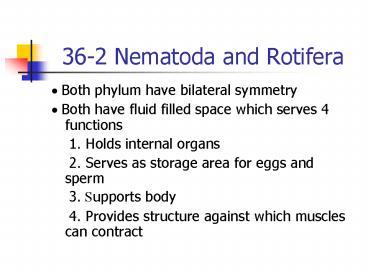36-2 Nematoda and Rotifera PowerPoint PPT Presentation
1 / 13
Title: 36-2 Nematoda and Rotifera
1
36-2 Nematoda and Rotifera
- Both phylum have bilateral symmetry
- Both have fluid filled space which serves 4
functions - 1. Holds internal organs
- 2. Serves as storage area for eggs and sperm
- 3. Supports body
- 4. Provides structure against which muscles
can contract
2
Phylum Nematoda
- Roundworms (transps. 134,135,158)
- Long slender bodies that taper at each end
- Known as pseudocoelomates
- hollow fluid-filled cavity that is lined by
mesoderm on outside, and endoderm on the inside - 1 mm to 120cm in length
3
Phylum Nematoda
- Have digestive tract with 2 openings
anterior end is mouth and posterior end is anus.
Food goes in mouth and moves in only 1 direction.
This is better than a gastrovascular cavity. - Separate sexes
- Protective noncellular covering called
cuticle - Free living on land and in salt water or
fresh water - Some are parasites
4
1. Genus Ascaris
- Parasitic in intestines of pigs, horses and
humans (fig. 36-7 p.716) - 1 ft. in length
- 1 female produces 200,000 eggs/day
5
Life Cycle
- Fertilized eggs in feces of hosts
- New host ingests contaminated food or water
- Eggs develop in intestines. Larvae form, go
through bloodstream to lungs to throat. Coughed
up and swallowed and returned to intestines.
6
2. Hookworms
- Always parasitic
- Feed on hosts blood
- Life cycle similar to Ascaris
- Affect 400 million people. Especially in the
tropical regions
7
3. genus Trichinella
- Parasitic in walls of hosts intestines
- Larvae go to muscles and form cysts
- Get by eating raw meat (usually pork). Called
trichinosis. Pretty rare in the USA.
8
Other Parasitic Roundworms
- 1. Pinworm
- Most common in the USA
- Causes no serious disease
- 2. Filarial worms
- Parasitic
- Usually in the tropics
- Larvae develop in the mosquito
- a.Elephantiasis limbs accumulate excess
water and swell - b. heartworm disease clogs arteries and
heart of dogs (and some cats
9
Pinworm
10
Elephantiasis
11
Heartworm Disease
12
Phylum Rotifera
- Called rotifers
- Free living and transparent and in fresh
water - Can survive without water for a long time. They
dry up and when wet conditions return, they
resume life
- Separate sexes
- Draw and label fig. 36-10 p. 718
- Define or explain purpose
- cilia
- mastax
- cloaca
13
Rotifera

